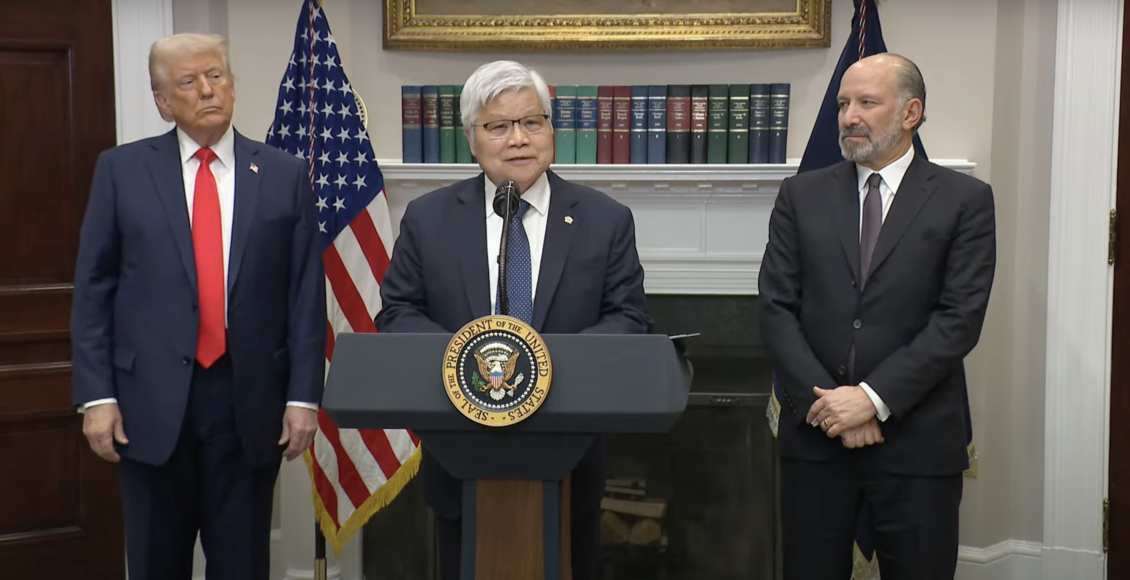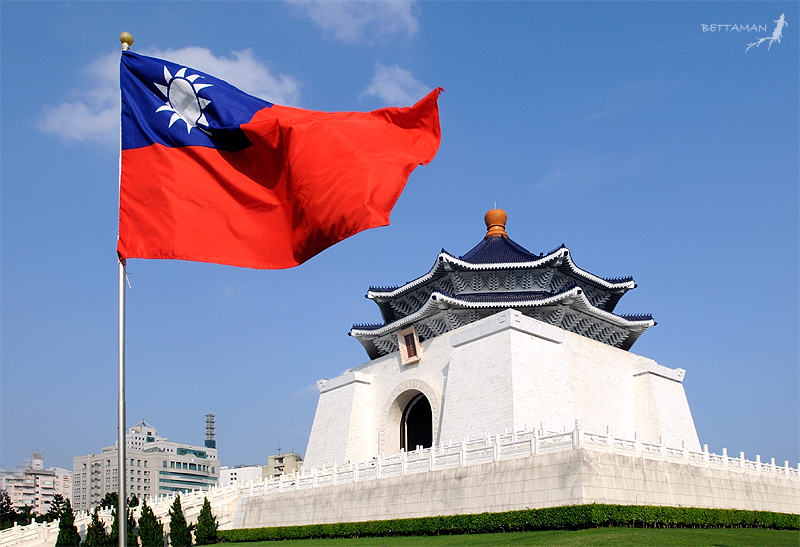All in on Chips: The Geopolitical Implications of the New TSMC Deal
 Featured image: C.C. Wei, Chairman and CEO of Taiwan Semiconductor Manufacturing Company (TSMC), stands next to Donald Trump and Commerce Secretary Howard Lutnick on Monday, March 3rd, as they announced new investments. Screenshot from The White House Youtube taken at 5:38.
Featured image: C.C. Wei, Chairman and CEO of Taiwan Semiconductor Manufacturing Company (TSMC), stands next to Donald Trump and Commerce Secretary Howard Lutnick on Monday, March 3rd, as they announced new investments. Screenshot from The White House Youtube taken at 5:38.
On Monday, March 3, C.C. Wei, CEO of Taiwan Semiconductor Manufacturing Company (TSMC)—the world’s largest computer chip manufacturing company—announced alongside President Trump a $100 billion USD investment to expand America’s semiconductor manufacturing capabilities. The momentous investment will go towards building five new TSMC facilities in Arizona, including a research & development centre, potentially creating thousands of jobs and bolstering the United States’ technological independence, reducing reliance on overseas chip production. This new commitment builds upon $65 billion dollars TSMC already invested in advanced semiconductor manufacturing operations in Phoenix, Arizona, where they currently employ more than 3000 workers on 1,100 acres of land.

TSMC is the world’s largest chip manufacturing company, at the forefront of semiconductor technology. The advanced semiconductor chips produced by TSMC power a vast majority of electronic devices in the world, from smartphones to cars to graphical processing units that power AI. Their customers include Apple, AMD, Nvidia, and Google. To paint a picture of the scale that TSMC operates at, the company is estimated to produce 90 per cent of the world’s super-advanced semiconductors, holding more than three times the market share of its nearest competitor, Samsung—they have almost total dominance over the sector. TSCM has existing chip fabrication plants—called fabs—in eastern China and Washington state, although its central operations still remain in Taiwan.
Although this deal is the biggest to date, policies to bring chip manufacturing into the US and boost the domestic semiconductor sector is nothing new. The Creating Helpful Incentives to Produce Semiconductors (CHIPS) and Science Act, passed into legislation under the Biden Administration in 2022, provides $52.7 billion USD in subsidies and incentives to encourage semiconductor production and research on American soil. It’s a way to lure manufacturing companies back into the US, re-establishing it as an industry leader in semiconductor technology—a status which has been lost since the 1990s. Back then, the US produced almost 40 percent of the world’s semiconductor supply, a statistic which fell to below 12 per cent in recent years.
With the decline of the US as the world’s eminent semiconductor manufacturer, Taiwan found itself on the rise. Now, they produce over 60 per cent of the world’s supply of semiconductors and more than 90 per cent of the most advanced chips. This new deal falls in line with the Trump administration’s larger push to encourage domestic American chip manufacturing in the name of reducing national security risks from imported chips, and, in line with Trump’s rhetoric, take back the chip manufacturing business that Taiwan “stole” from the US.
In a speech to House Republicans on January 27, Trump said he plans to impose 100 per cent tariffs on all imported semiconductors. His goal is to boost domestic production—supporting American companies like Intel—whilst encouraging foreign companies to manufacture domestically in order to bypass tariffs. “In the very near future, we are going to be placing tariffs on foreign production of computer chips, semiconductors… to return production of these essential goods to the United States,” said the President. “They left us and they went to Taiwan… and we want them to come back”. TSMC’s new $100 billion investment can be seen as a strategic move to avoid the tariffs while simultaneously taking advantage of funding from the CHIPS act.
This shift in semiconductor manufacturing carries significant geopolitical consequences. From artificial intelligence to national security, the semiconductor industry is at the heart of global technological competition. The US aims to secure its supply chains and reduce reliance on Taiwan, but these efforts may have unintended consequences—pushing China to accelerate its own technological independence and reshaping Taiwan’s strategic position. Outlined below are three key ways this deal impacts geopolitics.
AI: The advanced chips made by TSMC are often the structural basis used to power Nvidia’s graphics processing units (GPUs), a critical component of creating computers capable of training and running AI models. By shifting production to the US, this deal enhances America’s ability to secure a steady supply of high-end chips, reducing dependence on Taiwan and shielding critical AI infrastructure from geopolitical or supply chain disruptions.
However, this is not purely good news for the US. Looking at the astounding revelation of DeepSeek, a Chinese AI model that rivals the performance of ChatGPT without using the high-end GPUs produced in the west, it’s apparent that cutting China off from advanced chips is not an insurmountable obstacle to its AI ambitions. Instead, it has pushed China to develop alternative solutions, raising questions about the long-term effectiveness of US export controls and whether they might inadvertently fuel China’s drive for technological self-sufficiency.

Taiwan: The supremacy of Taiwan in the production of semiconductors has been referred to by many as a “silicon shield” that serves to ward off aggression. The argument is that since China’s industrial industry depends on Taiwanese semiconductors, an attack would be economically self-destructive. Furthermore, the US currently depends on Taiwan’s semiconductor technology and has a strong incentive to prevent it from falling into China’s hands, increasing the likelihood of American intervention in the case of Chinese interference or invasion. Taiwan has made an effort to retain its most cutting-edge semiconductor technology domestically for this reason. Until recently, TSMC maintained that Taiwan would continue to be the location of its R&D activities and the manufacturing of its most advanced processors. Some in Taiwan are alarmed by TSMC’s most recent declaration, believing the US is “hollowing out” the island’s semiconductor sector. There are worries that America would deprioritize Taiwan once it has enough local chip production capability.
Taiwanese law dictates that government approval must be given for any large overseas investments. Taiwan’s cabinet has made a declaration that the TSMC deal is under review, citing concerns for the above reasons. To combat the concerns about national security, the Presidential Office of Taiwan has requested that while TSMC expands operations in the US, “the most advanced processes will remain in Taiwan”.
China: China has long claimed sovereignty over Taiwan, but the democratically elected government in Taipei rejects these claims. Amidst rising tensions, any conflict in the Taiwan Strait could disrupt global AI and computing industries. By diversifying its geological footprint and moving some production to the US, TSMC reduces their risk of losing its manufacturing capacity in the event of a conflict between Taiwan and China. Additionally, this deal is another step in Taiwan’s efforts to strengthen ties with the US President Trump has previously voiced skepticism about defending Taiwan—suggesting instead that the protection that the US could offer should be paid for by Taiwan. Granting TSMC to invest billions into the US economy could be Taiwan’s way of changing this transactional narrative into one of cooperation and mutual benefit.
The shifting landscape of semiconductor manufacturing is more than just an economic story—it’s a geopolitical realignment with far-reaching consequences. The US is taking aggressive steps to reclaim its dominance in chip production, leveraging tariffs, subsidies, and strategic investments to reduce reliance on Taiwan and counter China’s technological rise.
However, these moves come with risks. While TSMC’s investment in the US strengthens American supply chains, it also raises concerns in Taiwan about losing its “silicon shield” and accelerates China’s drive toward self-sufficiency. In the long run, this realignment could reshape global power structures in technology and trade, determining who controls the future of AI, computing, and innovation. The question remains: Will this strategy make the US more secure, or will it spark an arms race in semiconductor independence that creates more instability?
Featured image: C.C. Wei, Chairman and CEO of Taiwan Semiconductor Manufacturing Company (TSMC), stands next to Donald Trump and Commerce Secretary Howard Lutnick on Monday, March 3rd, as they announced new investments. Screenshot from The White House Youtube taken at 5:38.
Edited by Allison Dera
